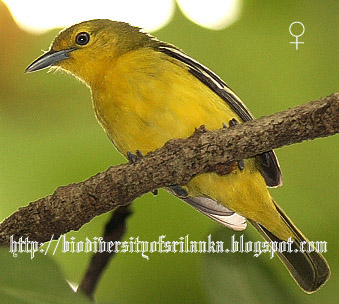English Post >>
Pages
- Home
- Flora of Sri Lanka
- Dragonflies & Damselflies of Sri Lanka
- Butterflies of Sri Lanka
- Freshwater Fishes of of Sri Lanka
- Amphibians of Sri Lanka
- Snakes of Sri Lanka
- Tetrapod Reptiles of Sri Lanka
- Mammals of Sri Lanka
- Resident Birds of Sri Lanka
- Migrant Birds of Sri Lanka
- Vagrant Birds of Sri Lanka
- Status Uncertain or Doubtful Birds of Sri Lanka
Showing posts with label Ioras. Show all posts
Showing posts with label Ioras. Show all posts
Saturday, August 17, 2024
පෙඳසුදු අයෝරාවා (Aegithina nigrolutea)
පහත රට වියලි කලාපයේ, දිවයිනේ නැගෙනහිර සිට දකුණු දෙසට විහිදුණු කොටසක වනාන්තර, විවෘත ගස් කොළන් සහිත ප්රදේශ සහ අතරින් පතර ගස් සහිත ලඳු කැලෑ වල ස්ථානීය වශයෙන් එතරම් සුලභ නොවන ලෙස හමුවන දේශීය පක්ෂියෙකි. ජෝඩු වශයෙන් ජීවත් වන අතර, කෙඳි වර්ග සහ කෝටු කැබැලි උපයෝගි කරගෙන පඳුරක පහල මට්ටමේ අතු කිහිපයක් එක්කර හෝ කරුවක තනන විවෘත කෝප්පයක හැඩැති කූඩුවක බිත්තර දමා වසරේ මුල් මාස කිහිපයේ අභිජනනය සිදුකරයි.
Friday, March 22, 2024
Marshall's Iora/White-tailed Iora/පෙඳසුදු අයෝරාවා (Aegithina nigrolutea)
An uncommon breeding resident, locally inhabiting forests, open wooded areas and scrub lands with scattered trees in the dry lowlands from east to south. It lives as pairs and breeds in first half of the year. The open cup shape nest, made out of fibers and small sticks is placed low on a bush, attached to a twig(s) or in a fork.
සිංහලෙන් කියවන්න >>
Saturday, March 28, 2020
කහ පණුකුරුල්ලා/පොදු අයෝරාවා(Aegithina tiphia)
සුලභ දේශීය පක්ෂියෙකු වන කහ පණුකුරුල්ලා හෙවත් පොදු අයෝරාවා පහත රට තැනිතලා ප්රදේශ වල සිට මුහුදු මට්ටමේ සිට මීටර 1000 දක්වා පමණ වූ පහල කඳුකරය දක්වා ගෙවතු, බඩවැටි සහ වනාන්තර මායිම් වල හමුවේ. නමුත් වියලි කලාපයේ වඩාත් සුලභව දැකිය හැක. යුගල වශයෙන් ජීවත් වන කහ පණුකුරුල්ලන් ගස් වල අතු පතර හමුවන කෘමීන් විශේෂයෙන් දලඹුවන් ආහාරයට ගනී. ආහාර සොයමින් ගස් අතර සැරිසැරීමේදි එකිනෙකා අතර විවිධ ආකාරයේ සියුරු සන් ශබ්ද නිකුත් කරමින් සබදතාවය පවත්වා ගන්නා ආකාරය නිරික්ෂණය කල හැක. අප්රේල් සිට ජූනි දක්වා කාලයේ ගසක අත්තක් මත කෙඳි වර්ග සහ මකුළු දැල් උපයෝගි කරගනිමින් සෑදූ කෝප්පයක හැඩැති කුඩා කූඩුවක බිත්තර 2 ක් හෝ 3 ක් දමා අභිජනනයේ යෙදේ.
English Post >>
English Post >>
Wednesday, February 8, 2012
Common Iora (Aegithina tiphia)
Common Iora is a very common breeding
resident distributed mainly in gardens, scrublands, and forest edges of low
country and lower hills up to 1000m a.s.l. But it is much common in dry zone.
Iora lives in pairs and feeds on insects, especially on caterpillars among
leaves of trees. While feeding it keeps in touch with each others by frequently
calling in variety of whistling sounds. Breeding season is mainly from April to
June and the nest a little cup made out of fibers and cobwebs fastened to a twig
of a tree where it lays 2 or 3 eggs.
සිංහලෙන් කියවන්න >>
Subscribe to:
Comments (Atom)




